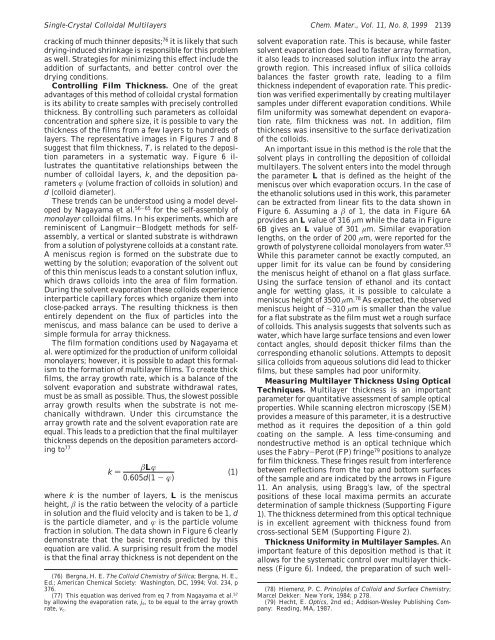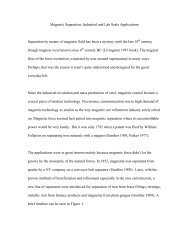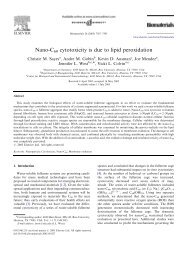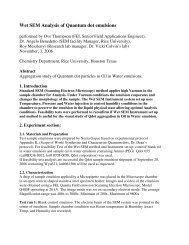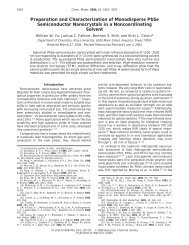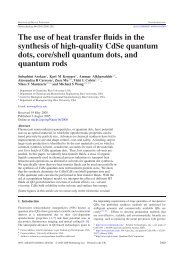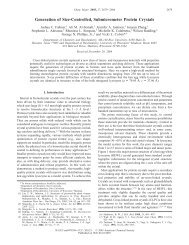Single-Crystal Colloidal Multilayers of Controlled Thickness
Single-Crystal Colloidal Multilayers of Controlled Thickness
Single-Crystal Colloidal Multilayers of Controlled Thickness
You also want an ePaper? Increase the reach of your titles
YUMPU automatically turns print PDFs into web optimized ePapers that Google loves.
<strong>Single</strong>-<strong>Crystal</strong> <strong>Colloidal</strong> <strong>Multilayers</strong> Chem. Mater., Vol. 11, No. 8, 1999 2139<br />
cracking <strong>of</strong> much thinner deposits; 76 it is likely that such<br />
drying-induced shrinkage is responsible for this problem<br />
as well. Strategies for minimizing this effect include the<br />
addition <strong>of</strong> surfactants, and better control over the<br />
drying conditions.<br />
Controlling Film <strong>Thickness</strong>. One <strong>of</strong> the great<br />
advantages <strong>of</strong> this method <strong>of</strong> colloidal crystal formation<br />
is its ability to create samples with precisely controlled<br />
thickness. By controlling such parameters as colloidal<br />
concentration and sphere size, it is possible to vary the<br />
thickness <strong>of</strong> the films from a few layers to hundreds <strong>of</strong><br />
layers. The representative images in Figures 7 and 8<br />
suggest that film thickness, T, is related to the deposition<br />
parameters in a systematic way. Figure 6 illustrates<br />
the quantitative relationships between the<br />
number <strong>of</strong> colloidal layers, k, and the deposition parameters<br />
(volume fraction <strong>of</strong> colloids in solution) and<br />
d (colloid diameter).<br />
These trends can be understood using a model developed<br />
by Nagayama et al. 56-65 for the self-assembly <strong>of</strong><br />
monolayer colloidal films. In his experiments, which are<br />
reminiscent <strong>of</strong> Langmuir-Blodgett methods for selfassembly,<br />
a vertical or slanted substrate is withdrawn<br />
from a solution <strong>of</strong> polystyrene colloids at a constant rate.<br />
A meniscus region is formed on the substrate due to<br />
wetting by the solution; evaporation <strong>of</strong> the solvent out<br />
<strong>of</strong> this thin meniscus leads to a constant solution influx,<br />
which draws colloids into the area <strong>of</strong> film formation.<br />
During the solvent evaporation these colloids experience<br />
interparticle capillary forces which organize them into<br />
close-packed arrays. The resulting thickness is then<br />
entirely dependent on the flux <strong>of</strong> particles into the<br />
meniscus, and mass balance can be used to derive a<br />
simple formula for array thickness.<br />
The film formation conditions used by Nagayama et<br />
al. were optimized for the production <strong>of</strong> uniform colloidal<br />
monolayers; however, it is possible to adapt this formalism<br />
to the formation <strong>of</strong> multilayer films. To create thick<br />
films, the array growth rate, which is a balance <strong>of</strong> the<br />
solvent evaporation and substrate withdrawal rates,<br />
must be as small as possible. Thus, the slowest possible<br />
array growth results when the substrate is not mechanically<br />
withdrawn. Under this circumstance the<br />
array growth rate and the solvent evaporation rate are<br />
equal. This leads to a prediction that the final multilayer<br />
thickness depends on the deposition parameters according<br />
to 77<br />
k )<br />
L<br />
0.605d(1 - )<br />
(1)<br />
where k is the number <strong>of</strong> layers, L is the meniscus<br />
height, is the ratio between the velocity <strong>of</strong> a particle<br />
in solution and the fluid velocity and is taken to be 1, d<br />
is the particle diameter, and is the particle volume<br />
fraction in solution. The data shown in Figure 6 clearly<br />
demonstrate that the basic trends predicted by this<br />
equation are valid. A surprising result from the model<br />
is that the final array thickness is not dependent on the<br />
(76) Bergna, H. E. The Colloid Chemistry <strong>of</strong> Silica; Bergna, H. E.,<br />
Ed.; American Chemical Society: Washington, DC, 1994; Vol. 234, p<br />
376.<br />
(77) This equation was derived from eq 7 from Nagayama et al. 57<br />
by allowing the evaporation rate, je, to be equal to the array growth<br />
rate, vc.<br />
solvent evaporation rate. This is because, while faster<br />
solvent evaporation does lead to faster array formation,<br />
it also leads to increased solution influx into the array<br />
growth region. This increased influx <strong>of</strong> silica colloids<br />
balances the faster growth rate, leading to a film<br />
thickness independent <strong>of</strong> evaporation rate. This prediction<br />
was verified experimentally by creating multilayer<br />
samples under different evaporation conditions. While<br />
film uniformity was somewhat dependent on evaporation<br />
rate, film thickness was not. In addition, film<br />
thickness was insensitive to the surface derivatization<br />
<strong>of</strong> the colloids.<br />
An important issue in this method is the role that the<br />
solvent plays in controlling the deposition <strong>of</strong> colloidal<br />
multilayers. The solvent enters into the model through<br />
the parameter L that is defined as the height <strong>of</strong> the<br />
meniscus over which evaporation occurs. In the case <strong>of</strong><br />
the ethanolic solutions used in this work, this parameter<br />
can be extracted from linear fits to the data shown in<br />
Figure 6. Assuming a <strong>of</strong> 1, the data in Figure 6A<br />
provides an L value <strong>of</strong> 316 µm while the data in Figure<br />
6B gives an L value <strong>of</strong> 301 µm. Similar evaporation<br />
lengths, on the order <strong>of</strong> 200 µm, were reported for the<br />
growth <strong>of</strong> polystyrene colloidal monolayers from water. 63<br />
While this parameter cannot be exactly computed, an<br />
upper limit for its value can be found by considering<br />
the meniscus height <strong>of</strong> ethanol on a flat glass surface.<br />
Using the surface tension <strong>of</strong> ethanol and its contact<br />
angle for wetting glass, it is possible to calculate a<br />
meniscus height <strong>of</strong> 3500 µm. 78 As expected, the observed<br />
meniscus height <strong>of</strong> ∼310 µm is smaller than the value<br />
for a flat substrate as the film must wet a rough surface<br />
<strong>of</strong> colloids. This analysis suggests that solvents such as<br />
water, which have large surface tensions and even lower<br />
contact angles, should deposit thicker films than the<br />
corresponding ethanolic solutions. Attempts to deposit<br />
silica colloids from aqueous solutions did lead to thicker<br />
films, but these samples had poor uniformity.<br />
Measuring Multilayer <strong>Thickness</strong> Using Optical<br />
Techniques. Multilayer thickness is an important<br />
parameter for quantitative assessment <strong>of</strong> sample optical<br />
properties. While scanning electron microscopy (SEM)<br />
provides a measure <strong>of</strong> this parameter, it is a destructive<br />
method as it requires the deposition <strong>of</strong> a thin gold<br />
coating on the sample. A less time-consuming and<br />
nondestructive method is an optical technique which<br />
uses the Fabry-Perot (FP) fringe 79 positions to analyze<br />
for film thickness. These fringes result from interference<br />
between reflections from the top and bottom surfaces<br />
<strong>of</strong> the sample and are indicated by the arrows in Figure<br />
11. An analysis, using Bragg’s law, <strong>of</strong> the spectral<br />
positions <strong>of</strong> these local maxima permits an accurate<br />
determination <strong>of</strong> sample thickness (Supporting Figure<br />
1). The thickness determined from this optical technique<br />
is in excellent agreement with thickness found from<br />
cross-sectional SEM (Supporting Figure 2).<br />
<strong>Thickness</strong> Uniformity in Multilayer Samples. An<br />
important feature <strong>of</strong> this deposition method is that it<br />
allows for the systematic control over multilayer thickness<br />
(Figure 6). Indeed, the preparation <strong>of</strong> such well-<br />
(78) Hiemenz, P. C. Principles <strong>of</strong> Colloid and Surface Chemistry;<br />
Marcel Dekker: New York, 1984; p 278.<br />
(79) Hecht, E. Optics, 2nd ed.; Addison-Wesley Publishing Company:<br />
Reading, MA, 1987.


